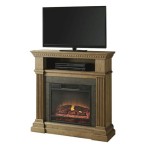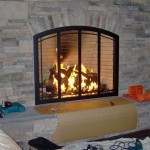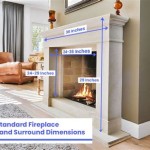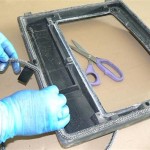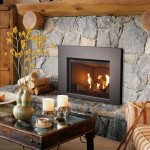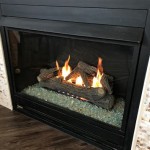Can You Buy Replacement Logs For A Gas Fireplace?
The question of whether one can purchase replacement logs for a gas fireplace is a common inquiry among homeowners and individuals seeking to maintain or enhance the aesthetic appeal of their heating appliances. Gas fireplaces, renowned for their convenience and ease of use, often feature ceramic or refractory logs that mimic the appearance of real wood. Over time, these logs can become damaged, chipped, discolored, or simply lose their visual appeal. The ability to replace them offers a practical solution for preserving the fireplace's ambiance and functionality.
The answer, in short, is yes; replacement logs for gas fireplaces are readily available. However, a successful replacement requires careful consideration of several factors, including the fireplace type, burner configuration, log material, and safety standards. A proper understanding of these elements is critical to ensure that the replacement logs are compatible with the existing fireplace system and do not compromise its safe operation.
The following sections will delve into the specifics of gas fireplace log replacement, covering essential aspects such as identifying the correct log set, understanding different log materials, and ensuring safe installation practices. By addressing these key areas, this article aims to provide a comprehensive guide for those considering replacing the logs in their gas fireplace.
Identifying the Correct Replacement Log Set
Selecting the appropriate replacement log set begins with accurately identifying the type and model of the existing gas fireplace. This information is crucial because gas fireplaces are designed with specific burner configurations and venting systems, which dictate the size, shape, and arrangement of the logs. Using an incompatible log set can obstruct gas flow, interfere with the burner's performance, and potentially create a hazardous situation.
The fireplace's model number is usually found on a metal plate or sticker located inside the firebox, behind the control panel, or on the unit's exterior. Consult the manufacturer's website or owner's manual, using the model number to determine the exact specifications for compatible replacement logs. Some manufacturers provide detailed diagrams showing the correct placement of each log within the firebox. Adhering to these specifications is paramount for achieving optimal flame patterns and preventing carbon monoxide buildup.
If the model number is not readily accessible, carefully measure the dimensions of the firebox and the existing logs. These measurements will help in determining the appropriate size and configuration of the replacement log set. Pay particular attention to the width, depth, and height of the firebox, as well as the individual log dimensions. Online retailers and fireplace specialty stores often provide detailed product descriptions and specifications, allowing consumers to compare different log sets and find a suitable match.
Furthermore, consider the type of gas used in the fireplace – natural gas or propane. Log sets are often designed for a specific fuel type, and using the wrong log set can result in inefficient combustion, soot formation, and potentially dangerous conditions. Verify that the replacement logs are certified and approved for use with the intended fuel source.
When in doubt, it is always advisable to consult a qualified fireplace technician. They can assess the fireplace system, identify the correct replacement log set, and ensure that it is installed properly and safely. Professional assistance can prevent costly mistakes and guarantee the long-term performance of the gas fireplace.
Understanding Different Log Materials Used in Gas Fireplaces
The materials used to construct gas fireplace logs significantly impact their appearance, durability, and heat resistance. The two most common materials are ceramic fiber and refractory cement. Each material offers distinct advantages and disadvantages, influencing the overall performance and longevity of the log set.
Ceramic fiber logs are lightweight and highly realistic in appearance. They are crafted from spun ceramic fibers that are molded into intricate shapes resembling natural wood. Ceramic fiber logs are excellent at radiating heat, providing a comfortable and consistent warmth. They are also relatively inexpensive compared to refractory cement logs. However, ceramic fiber logs are more fragile and prone to chipping or cracking, especially when exposed to frequent handling or high temperatures. Over time, they may also lose their vibrant color due to prolonged exposure to the flame.
Refractory cement logs, on the other hand, are made from a dense, heat-resistant material. These logs are significantly heavier and more durable than ceramic fiber logs. Refractory cement logs can withstand higher temperatures and are less likely to crack or chip. They also tend to retain their color and appearance for a longer period. While refractory cement logs are more expensive, their enhanced durability and longevity often make them a worthwhile investment. They offer a more substantial and authentic feel, contributing to a more realistic fireplace experience.
In addition to ceramic fiber and refractory cement, some manufacturers use a combination of materials to create hybrid log sets. These hybrid logs may incorporate ceramic fibers for realistic detailing and refractory cement for added durability and heat retention. The specific blend of materials varies depending on the manufacturer and the intended application.
When selecting replacement logs, consider the desired balance between aesthetics, durability, and cost. If a realistic appearance and affordability are primary concerns, ceramic fiber logs may be a suitable choice. However, if longevity and robustness are paramount, refractory cement logs offer a superior option. Carefully evaluate the characteristics of each material to determine the best fit for the specific needs and preferences.
Regardless of the material selected, ensure that the replacement logs are specifically designed for use in gas fireplaces and meet relevant safety standards. Avoid using any materials that are not intended for high-temperature applications, as they may release harmful fumes or pose a fire hazard.
Ensuring Safe Installation Practices When Replacing Gas Fireplace Logs
Replacing gas fireplace logs is a relatively straightforward process, but prioritizing safety is crucial. Improper installation can lead to gas leaks, carbon monoxide poisoning, or fire hazards. Therefore, meticulous attention to detail and adherence to safety guidelines are essential.
Before commencing any work, turn off the gas supply to the fireplace completely. Locate the gas shut-off valve, typically situated near the fireplace or the gas meter, and turn it to the "off" position. Allow the fireplace to cool down entirely before handling the logs or any internal components. Disconnect the electrical power supply to the fireplace, if applicable, to prevent any accidental electrical shocks.
Carefully remove the existing logs, noting their original placement and orientation. It is helpful to take photographs or make a sketch of the log arrangement before disassembly. This will serve as a reference guide during the installation of the replacement logs. Inspect the burner assembly for any signs of damage, corrosion, or debris. Clean the burner ports with a soft brush or vacuum cleaner to ensure proper gas flow. Replace any damaged or worn-out components, such as the pilot light assembly or the thermocouple.
Consult the manufacturer's instructions for the replacement log set and follow the recommended installation procedures meticulously. Place each log in its designated position, ensuring that it is securely seated and properly aligned with the burner. Avoid obstructing the burner ports or interfering with the pilot light flame. The logs should be positioned in such a way that they do not come into direct contact with the burner or any other critical components.
After installing the replacement logs, turn on the gas supply and check for any gas leaks. Use a soapy water solution to test the gas connections. Apply the solution to the fittings and joints, and watch for any bubbles. If bubbles appear, it indicates a gas leak. Turn off the gas supply immediately and tighten the connections or replace any damaged components. Repeat the leak test until no bubbles are present.
Once the leak test is successful, turn on the fireplace and observe the flame pattern. The flame should be consistent and evenly distributed across the burner. If the flame is uneven, flickering, or yellow, it may indicate an issue with the gas supply, burner assembly, or log placement. Adjust the log positions as needed to achieve a proper flame pattern. If the problem persists, consult a qualified fireplace technician.
Finally, ensure that the fireplace is properly vented and that there are no obstructions in the venting system. Carbon monoxide is a colorless, odorless gas that can be deadly. Install a carbon monoxide detector near the fireplace and check it regularly to ensure that it is functioning correctly. If you suspect a carbon monoxide leak, evacuate the premises immediately and contact the fire department or a qualified technician.
Replacing gas fireplace logs can enhance the aesthetic appeal and functionality of the appliance. By carefully selecting the correct log set, understanding different log materials, and adhering to safe installation practices, homeowners can ensure a successful and safe replacement process.

How Long Do Gas Logs Last To Replace Fireplace

How Long Do Gas Logs Last To Replace Fireplace

How To Select And Install A Gas Fireplace Log Set Fireplaces Direct Learning Center

Warming Trend Update Gas Logs To Improve Performance And Appearance Walton

How Long Do Gas Logs Last To Replace Fireplace

Modern Gas Fireplace Logs Fire Glitter Fireballs And More

How Often Should You Replace The Logs In A Gas Fireplace Flame Company

The Best Gas Log Sets For 2024 Fireplaces Direct Learning Center

New Gas Logs For Fall Seattle Wa Pristine Sweeps

American Gas Log Dundee Oak 30 In Vented Natural Fireplace Set With Complete Kit Manual Match Lit Do30hdmtch The Home Depot
Related Posts

